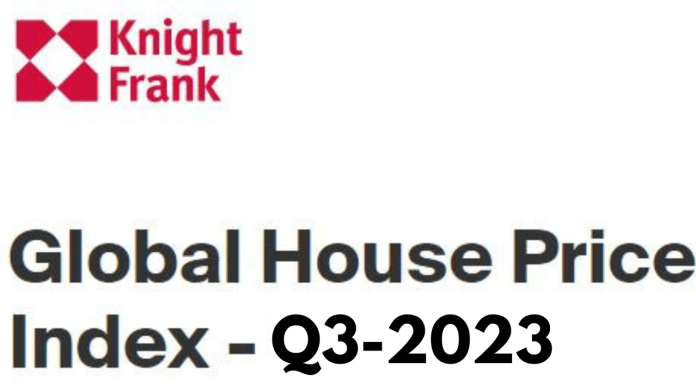India has achieved a remarkable feat, surging 18 positions to secure the 14th spot in Knight Frank’s Global House Price Index during the third quarter of 2023. India’s residential real estate market witnessed a substantial year-on-year growth of 5.9%, propelling the nation into the spotlight of the global property landscape.
- In Q3, India surged 18 points to 14th in Knight Frank’s global house price index.
- Globally, property prices increased at a 3.5% annual rate across the 56 markets.
- Over the last three years, home prices in India’s IT center micro-markets have risen by double digits.
Global Growth Trends
Across the 56 markets covered by Knight Frank’s Global House Price Index, home prices experienced an average growth of 3.5% year-on-year in September 2023. This marks a significant increase from the previous quarter, where global home prices saw a 2.2% uplift.
Driving Forces Behind India’s Housing Boom
Despite facing challenges such as elevated home loan rates and inflation threats, India’s residential market has flourished, primarily attributed to its stable economic growth. Government incentives provided during the pandemic played a pivotal role in stimulating the market.
Shishir Baijal, Chief Managing Director (CMD) of Knight Frank India, observed, “Given the current scenario of rising interest costs due to heightened inflation levels, the strong fundamentals of the domestic economy, coupled with the growing aspirations associated with residential real estate, are fueling increased demand among homebuyers in prominent residential markets within the country.”
Micro Markets Take the Lead
Certain micro markets in India, particularly tech hubs in Hyderabad, Bangalore, and Pune, experienced remarkable price surges ranging from 28% to 33% over the past three years, according to a report by Anarock.
The ongoing urbanization wave has further fueled infrastructure development, giving rise to emerging residential hubs in India’s urban centers, as emphasized by Baijal.
Resilience Amidst Price Rises
Despite the upward trajectory of property prices, the Indian housing market has proven robust. The third quarter of 2023 witnessed the sale of 3.49 lakh units in the top 7 cities, only slightly lower than the 3.65 lakh units sold in 2022.
Simultaneously, the overall sales value of housing inventory reached ₹3.48 lakh crore. The total residential property sales value in the first nine months of 2023 is already 7% higher than the entire year of 2022.
Post-Covid Revival
Prashant Rao, MD of Poulomi Estates, highlighted the significant shift in demand post-Covid. After a prolonged period of stagnant or declining property prices from 2013, the market experienced a revival, surpassing previous highs. Contributing factors include pent-up demand, a desire for upgrades, willingness to invest in better amenities, and overall economic and infrastructure improvements.
Global Rankings Overview
While Turkey maintained its top spot since Q1 of 2020, with an astounding growth of 89.2% year on year, India secured its position as a standout performer in the Asia-Pacific region with a 5.9% annual growth. Japan leads the region with 6.3% annual growth.
Liam Bailey, global head of research at Knight Frank, emphasized the surprising resilience of global house prices amid rising mortgage costs. He predicted that the key challenge for housing markets in 2024 would be low market liquidity, with sales volumes potentially decreasing by up to a quarter compared to recent peaks. A shift to lower interest rates is anticipated to catalyze increased sales activity.
Frequently Asked Questions (FAQ’s)
Ans: India’s rise to the 14th spot indicates a remarkable feat, with a notable surge of 18 positions in the third quarter of 2023, reflecting the country’s performance in the global real estate landscape.
Ans: India’s residential real estate market witnessed a substantial year-on-year growth of 5.9% during the third quarter of 2023.
Ans: India secured its position as a standout performer in the Asia-Pacific region with a 5.9% annual growth, leading the region alongside Japan, which had a 6.3% annual growth.









































